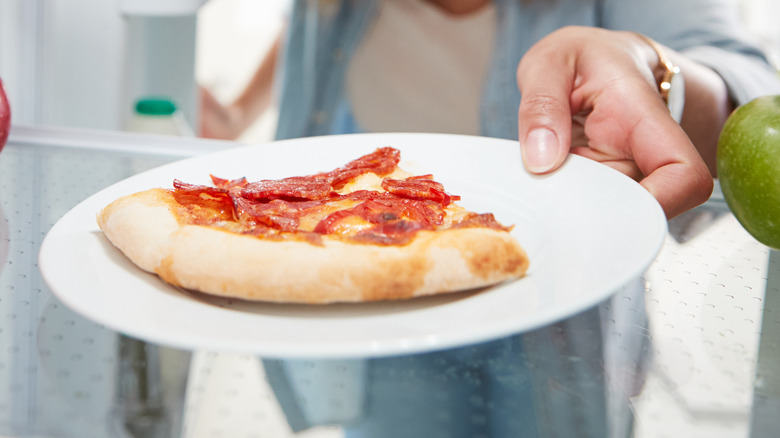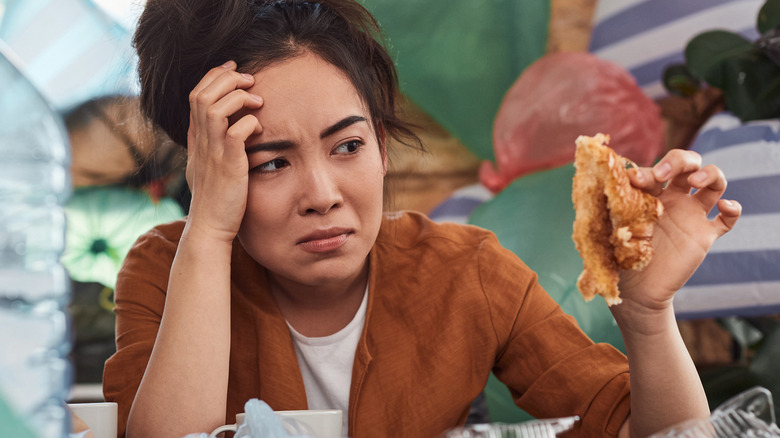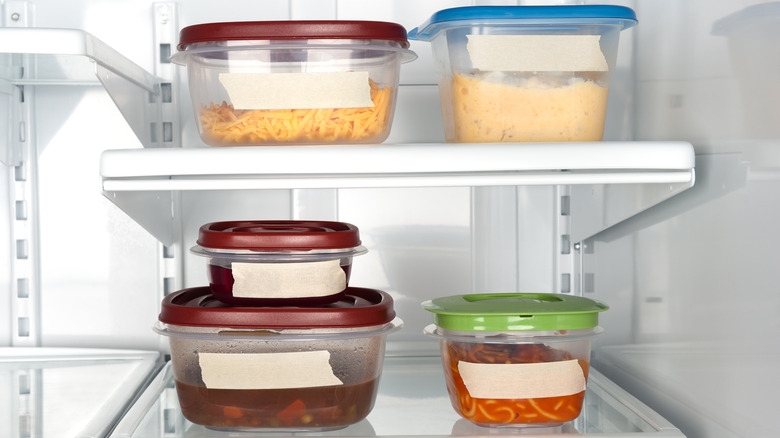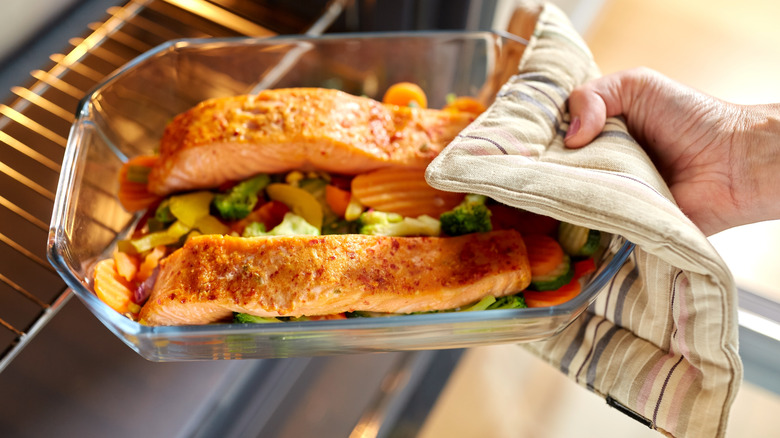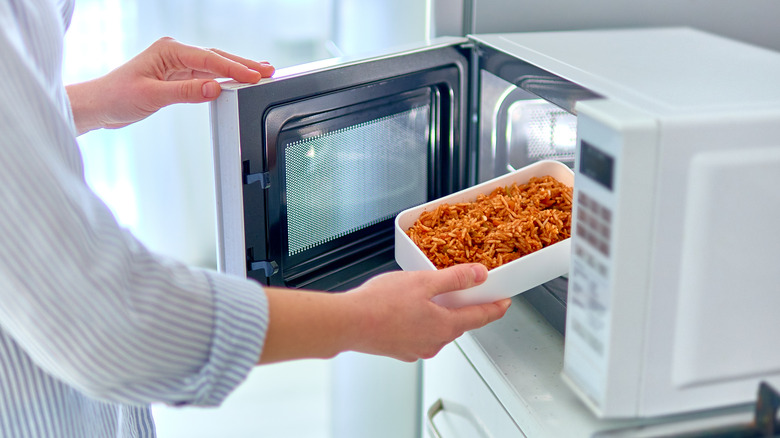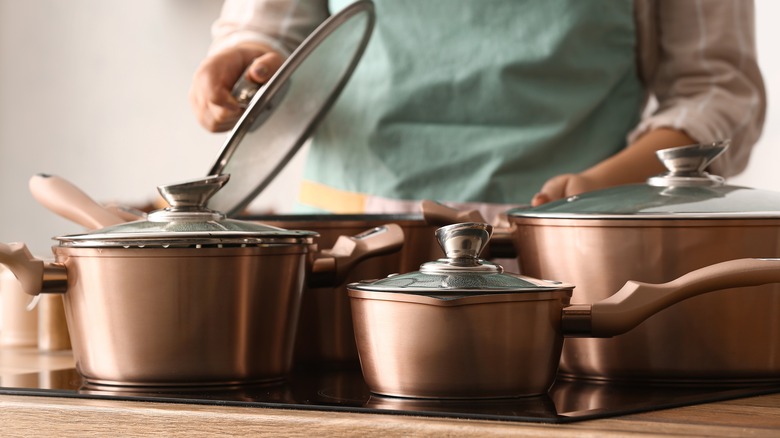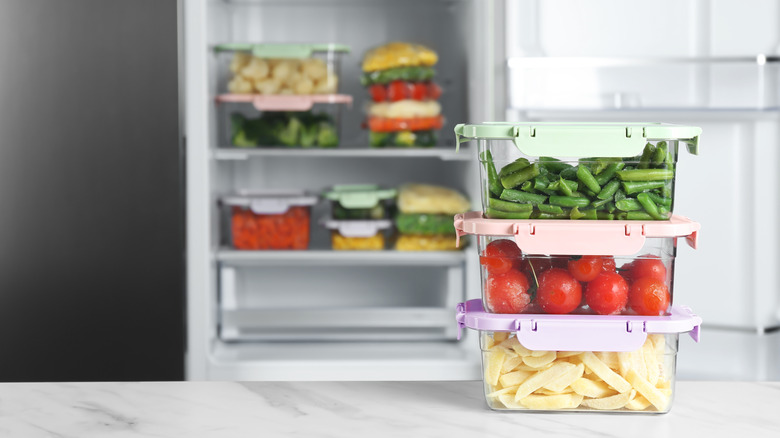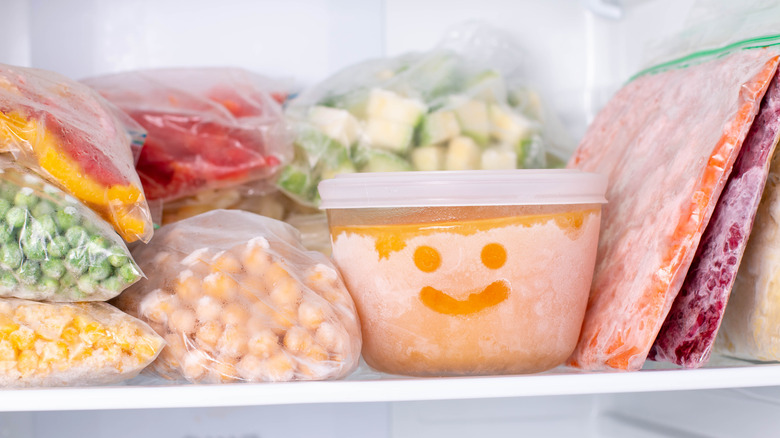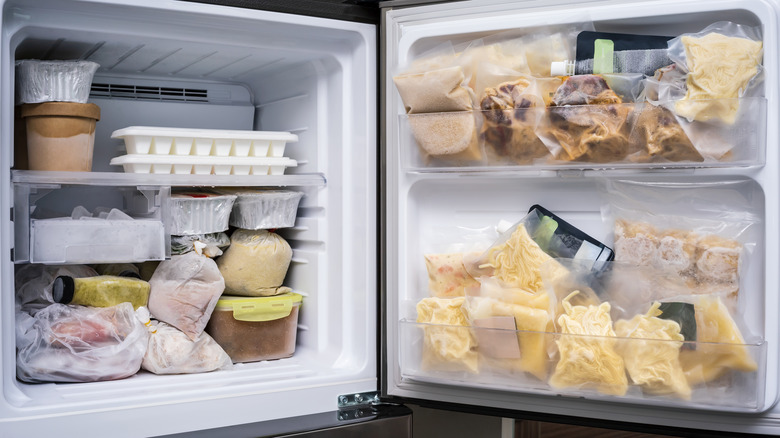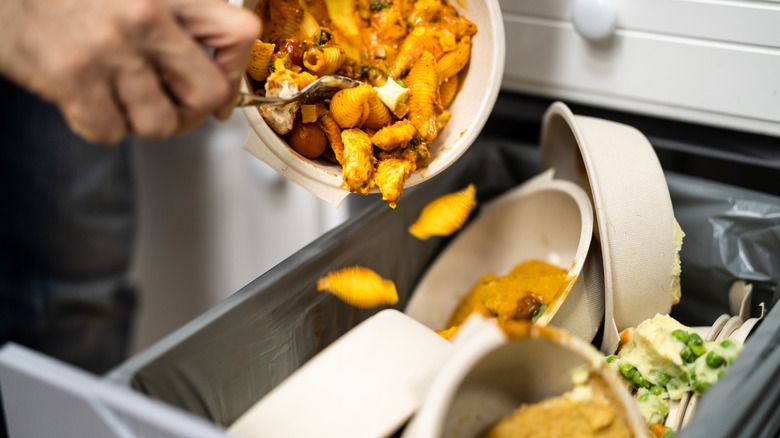Leftovers: The Complete Guide
If you have a habit of making too much food for yourself or your family, resulting in leftovers after most meals, you're not alone. One survey including 2,000 participants found that Americans, on average eat about three leftover meals weekly — only two less than freshly-cooked meals. Additionally, a whopping 72% of those surveyed said they are completely for leftovers (via Study Finds).
That's a good thing, as long as those leftovers get used. One potential problem of having too many leftovers is that they can go to waste if you forget about them or don't eat them quickly enough. U.S. government data finds that the average American consumer wastes 422 grams of food each day, which is close to one whole pound (via PLOS One). RTS adds that as much as 40% of the U.S.'s food supply gets wasted annually.
Managing leftovers properly in your household can be a simple way to do your part in reducing food waste, which could even have a positive impact on your budget. Continue reading to learn everything you need to know about hanging on to those leftovers.
You might be saving your leftovers too long
Once food has been cooked, it's safe to save as leftovers for several days without the fear of quickly-growing bacteria, right? According to experts, not so much. First, the U.S. Department of Agriculture's Food Safety and Inspection Service states that you should only keep most leftovers in the refrigerator for up to three or four days. If they're frozen, store them for three or four months safely. After that, it's best to toss them. Mayo Clinic says that the three-to-four-day rule is based on the fact that bacteria begin to grow after this time period, increasing the risk of a food-related illness.
The University of Minnesota Extension offers some additional guidance on specific foods that don't fall under the usual guidelines. For example, keep gravy and meat broth for only one to two days in the refrigerator. Meanwhile, luncheon meat is safe for about two weeks when its package is unopened, but open packages should be tossed after three to five days. To ensure that you don't keep your leftovers in the refrigerator too long, consider marking their containers with the date you made them before tucking them away on a fridge shelf.
What can happen if you eat leftovers that have gone bad?
Is it really that bad to eat leftovers past the maximum suggested length of time? It could be, depending on what you're eating. The reason there are suggested storage methods and times deemed safe for storing leftovers is because food really can make you sick if it's not properly stored and disposed of when its time is up.
When food isn't prepared and stored properly, it has a higher risk of breeding large amounts of bacteria that are known to cause foodborne illness, like shigella, campylobacter, and clostridium perfringens (via FoodSafety.gov). If you leave your leftovers out too long before putting them away or you eat them a week after they were cooked, you might come into contact with unhealthy levels of these dangerous bacteria. According to physician assistant Mike Cruise (via Samaritan Health Services), "Food poisoning symptoms can range between mild to very serious, depending on your physical condition and the type of bacteria you've ingested. There are some pretty common symptoms that come on shortly after eating, usually from within 30 minutes to several hours, such as upset stomach or nausea, stomach cramping, diarrhea, vomiting and fever."
Unfortunately, food poisioning isn't usually something you can treat, either. According to Cruise, rest, hydration, and waiting for symptoms to pass is the typical course of treatment to feel better.
Know the proper leftover storage temperatures
Storing leftovers at the right temperatures is the best way to make sure they're out of the food danger zone. The food danger zone is between 40 degrees and 140 degrees Fahrenheit. It's called the danger zone because, when food sits at this temperature range, bacteria can multiply to levels that are harmful to the human body. If you eat food containing high levels of these dangerous bacteria, you could get sick. Therefore, food — including leftovers — should always be stored in the refrigerator at less than 40 degrees or in the freezer at 0 degrees Fahrenheit (via the USDA Food Safety and Inspection Service).
Now, let's say you've reheated a bunch of leftovers for your family to have for lunch. Do you have to eat them immediately, or can you safely leave them out for a little while? The USDA Food Safety and Inspection Service says that hot foods need to be reheated to at least 165 degrees Fahrenheit. Then, you should keep them heated using warming plates or steaming tables to at least 140 degrees for a maximum of two hours. After that, it's time to put them back in the refrigerator. Similarly, cold leftovers that don't need to be reheated should be kept on ice to prevent them from rising to 40 degrees.
Here are the best ways to reheat leftovers
When it comes time to eat your leftovers, knowing how to reheat them properly is just as important as understanding the safest ways to store them in the refrigerator or freezer. Just like cooking food for the first time requires you to ensure that your food meets a certain temperature to be safe to eat, leftovers need to reach specific temperatures, too, to avoid bacteria growth that could make you sick. According to the USDA's Food Safety and Inspection Service, reheated foods should reach a minimum temperature of 165 degrees to be considered safe to eat.
The most important thing to remember is to reheat leftovers evenly. You can do this by reheating foods in the oven, pan, or microwave. If reheating foods in the oven, cover the oven-safe dish with aluminum foil to prevent the food from drying out (via Healthline). Broths, soups, and gravies cooked in a pot or pan should reach a rolling boil to indicate that they've reheated all the way through. Also, use a reliable food thermometer to take the temperature of your food before eating it (per the USDA's Food Safety and Inspection Service).
Can you microwave leftovers safely?
Microwaves are commonly used to reheat leftovers quickly and without needing to dirty other pots, pans, and casserole dishes to do it. However, is microwaving leftovers safe? According to Healthline, not only is it perfectly acceptable to reheat leftovers in the microwave, doing so may also help you keep some of the nutrients intact. Microwaving is the quickest reheating method, and it doesn't usually require additional liquids to prevent food from drying out, which could prevent nutrient loss that comes with other reheating methods.
With that said, there are a few things to remember if you're going to reheat food in the microwave. First, keep food in a single layer and occasionally stir and move your food during the cooking process to help it heat evenly, according to Cook's Illustrated senior editor Lan Lam (via Eat This, Not That!). Use only microwave-safe containers, avoiding plastic containers if possible (via the University of Minnesota Extension). Finally, if reheating leftovers from the freezer, keep them in the microwave until they've reheated thoroughly, rather than defrosting them and saving them in the refrigerator to finish cooking later. Michigan State University's MSU Extension notes that interrupting the cooking process puts your defrosted food in the temperature danger zone for bacterial growth.
You don't need to cool down leftovers before refrigerating them
You might have heard from your parents that leftover food needs to cool down first before it can go in the refrigerator. It seemed to be a general consensus that putting hot food directly into the fridge could harm the food. However, knowing what you know now about food safety and the food danger zone, you've probably determined that may not be a safe technique. If so, you'd be right.
Cooling down your food before putting it in the refrigerator can make it fall into danger zone temperatures, allowing bacteria to grow rapidly while the food lowers in temperature. And, leaving the food out of the refrigerator to cool, even for just a few minutes, could make it easier to forget about. The Washington State Department of Health says that any prepared and perishable foods you cook should go in the fridge within two hours of preparing them to avoid dangerous bacteria growth. And, if you do happen to forget your leftovers sitting at room temperature for two hours, you should throw them away.
Use proper leftover storage containers and methods
Consider this: You make a slow cooker full of chili for the family to enjoy over the next few days. When everyone's done eating it for tonight's dinner, there's still a lot left. You put the slow cooker pot right into the refrigerator during clean-up to help it cool down to a safe temperature quickly. The problem is, that large pot of chili is probably going to take a while to cool completely, which could leave it spending time in the food danger zone.
Instead, the USDA's Food Safety and Inspection Service suggests helping your food cool quicker by breaking it down into smaller containers. The chili would be better off split into a few shallow containers to cool down faster, while you can cut and portion solid foods, like meat and casseroles, to store them safely. As far as containers, the USDA's Food Safety and Inspection Service says airtight containers are your best bet to keep leftovers as fresh as possible for the three or four days you'll store them. If you need to put them away quickly, using an airtight wrap could work instead.
Freezing and refreezing extra leftovers safely
Freezing leftovers is an excellent way to avoid wasting food, especially if you have way more leftovers than you bargained for. The University of Illinois Urbana-Champaign Illinois Extension reminds consumers to use freezer-safe containers labeled with the date they made the food, storing them in an area of the freezer with ample space around them for proper airflow. Food safety specialist for the University of Georgia, Elizabeth Andress, Ph.D., tells Consumer Reports that using airtight wrapping or containers for frozen leftovers prevents air from harming the food's flavor, color, and overall quality.
Now, what do you do if you reheat frozen leftovers and still have extras you need to store? According to USDA food specialist Meredith Carothers (via Inverse), it's perfectly acceptable to refreeze leftovers. "From a safety perspective, as long as the food product that has thawed has been stored below 40 degrees Fahrenheit, it's safe to refreeze it," she says. However, Carothers adds that there's "potential of the quality getting poorer each time you thaw or refreeze it."
What to do with leftovers in case of a power outage
When a power outage hits your area, one of your first instincts might be to figure out what to do with your leftovers in the refrigerator. That's smart, because without power, your fridge can warm up quickly, leaving your leftovers to suffer the consequences. The Pennsylvania State University's PennState Extension states that food is generally okay in the refrigerator during a power outage for up to four hours. If you expect the power to be out longer than that, you can pack food into the freezer to keep it at safe storage temperatures for up to 48 hours. Or, if it's cold outside, pack your leftovers in an insulated cooler with ice and store the cooler outdoors.
Additionally, it's important to keep the refrigerator, freezer, or cooler closed as much as possible during the power outage to keep any cold air from escaping. If the air inside the storage space rises about 40 degrees, your leftovers should be thrown out after two hours (via FoodSafety.gov).
Preventing food waste from leftovers
Do you usually have leftovers after each meal? Of those leftovers, how often do you have to throw some away each week? If you toss extra food often, you're not alone. Food waste is rampant in the United States, with the country throwing away more food than any other country worldwide. While many areas are passing regulations to encourage composting and waste-reduction methods, much of the responsibility also lies at home (via RTS).
According to Hennepin, a good place to start is by using an online food calculator to determine how much food you need to cook your family. This can help you avoid cooking more servings than necessary and ending up with leftovers you may not finish. Hennepin also suggests turning leftovers into lunch for the next day — even repurposing foods into something new, if desired — or freezing your leftovers to store them longer. The United States Environmental Protection Agency also says that planning meals before going grocery shopping can help you avoid buying more ingredients and meals than you need.

